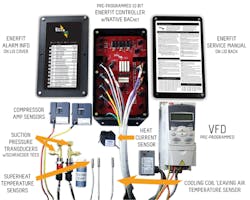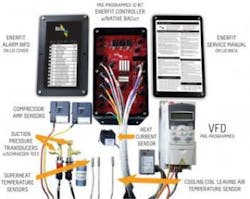Enerfit to Market Retrofit System for Single-zone HVAC Rooftop Units
A father-and-son team of entrepreneurs out of Chattanooga, TN are in the final weeks of finalizing Enerfit, an improved version of a retrofit system they say significantly improves the efficiency of single-zone rooftop HVAC units.
Ron Patch and his son Ben first marketed Enerfit in 2011. The first-generation unit has been installed on buildings in 35 states and Canada.
“We generally describe Enerfit as a retrofit for single-zone air conditioning units, that cuts the annual electric consumption in half or more, significantly reduces relative humidity, and on the service side, allows the building owner to get long-term savings by keeping the unit running properly,” inventor Ron Patch explains.
“Additionally, the service side has been ignored in rooftop system design. We’ve gone to a lot of trouble to make sure the needs of the service technician and service company are catered to in the way we’ve designed the product.”
Enerfit’s patented system monitors and responds to the operation of all air conditioning unit compressors, to protect the unit’s refrigeration system, while providing maximum reduction of unit electrical usage and space-relative humidity. The system consists of dampers, a control board, and a monitoring device that controls indoor-fan speed with a variable frequency drive, to match the variable air conditioning and heating requirements of the conditioned space.
No Waiting on Innovation. Patch believes rooftop system design has been deprived of true innovation, because it’s languished in what has for too long been a price-driven market. He says it isn’t until ASHRAE issues a new standard, or the Federal government mandates new levels of system efficiency that improvements occur.
“When engineers oversize the tonnage of rooftop units, and have a 20-ton unit serving a 15-ton need, they also oversize the airflow,” Patch says. “Consequently, buildings have high humidity in summer and draftiness in the shoulder months and winter.”
Enerfit is the natural next innovation for Ron Patch, who began his HVAC career as a sales engineer for Trane in 1970. Later, he was a manufacturer’s rep for McQuay, Aaon, and Baltimore Air Coil. In 1985, he started Electronic Controls, a provider of direct digital and pneumatic controls for new and existing facilities. In 1995, he formed ECI Industrial LLC, makers of custom industrial electronic panels.
Patch says he first came up with the idea for Enerfit while talking to a friend who worked in retail, and whose company was trying to improve rooftop unit performance with the newest variable frequency drives.
“He told me they were slowing the fan down in ventilation mode or heating mode, but not in cooling mode, due to the problem of slowing airflow on a direct expansion coil. That got me thinking because almost all of the rooftop unit’s operating hours are in cooling mode,” he says.
Patch says that as variable frequency drives became more cost effective and smaller, the opportunity arrived to design something like Enerfit, that is more compatible with small rooftop interior spaces, and more affordable.
“That coincided with the fact that people are very interested in energy consumption reduction at the rooftop level, not just in the mechanical room,” he says.
Patch installed an initial version on the roof of his panel shop. A year and a half later, he developed other improvements. Patch says the original Enerfit system had an excessive amount of field low-voltage terminations.
“That made the installation very slow, and provided opportunities for mistakes. Our current version is a minimum of five and maximum of 11 field low-voltage wire terminations,” he explains. “Someone with basic HVAC service skills could install these all day after proper instruction.”
He now has two patents on it, and is ready for mainstream distribution. For additional information, visit enerfit.com.

